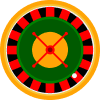Bauernroulette - German Roulette
Apparently created within the confines of the German nation hundreds of years ago, Bauernroulette or German Roulette is pretty popular amongst elementary school-aged children in that country and in other around the world. There are several companies that sell it as a child’s game.
In German bauern stands for farmer or peasant, or someone that tills that land and the direct translation is considered by many to be the ‘poor man’s roulette.’
Rules Of The Game:
- There is a special top that is spun and it is centered in the middle of some sort of board, which could be constructed of any material.
- Normally there are six balls, with four being white, one red and one green and they go right smack in the board’s center. These balls can also come in different colors depending on what version of the game you play.
- Once the balls are in place, the top is spun within their center and it can last as long as you choose.
- Obviously the balls are pushed to different areas or indentations within the board from the force of the top and each compartment possesses a specific numeric value.
- The deeper indentations are worth more points.
- If the red ball happens to venture into a shallower area the player doubles up their points.
- When the green ball rolls in the same sized space, points are detracted from the player’s total points accumulated from all of the other balls played.
- If the balls miss their marks from a particularly forceful spin of the top, the player is not allowed to perform their spin again and sit that round out.
- If a player is lucky enough to have every one of the six playing pieces light into all indented areas, they are allowed an extra round.
- Players decide how many points must be accumulated to be triumphant in the game before they ever commence play. Whoever reaches the established mark first is the victor. For most instances, players use the figure of 1,000 points.
